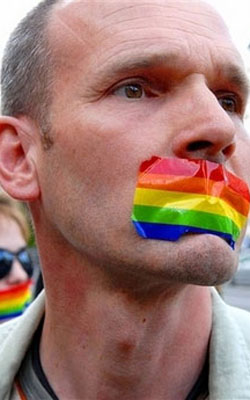What can we learn from the fiasco of the demonstration against the deaths of homosexuals by the "rainbow maniac", which brought together just half a dozen cats in Parque do Paturis, in Carapicuíba, on the outskirts of Greater São Paulo? Do groups that defend our rights know how to organize a protest? Or have gays stopped believing in militancy or are they just alienated? The search for these answers opened the 2009 season of fierce discussions in LGBT forums, after A Capa (which covered the protest) publicized the failure of the political act, generating a wave of comments and repercussions in the gay media.
Since 1994, I have covered dozens of street protests as a reporter, some even involving violent clashes with the police. I have already infiltrated radical parties, inspired by communist ideology, which have always seen a demonstration as a war operation, with well-defined strategies to occupy spaces and even an instinct for danger, such as defining who will face police shields and batons to render the most shocking images for newspapers and TV and, thus, give more visibility to the cause and bring about change. Below are some points I learned during this period about the art of mobilizing crowds and taking a flag to its ultimate consequences.
1- Right time, right place: find out the day and time that will attract the most people, talk to your target audience in advance, investigate access and transport facilities, provide travel options in a pamphlet or email, maps. Check the weather forecast for the day. Look for intermediate times (not too early, not too late). Ask, for example, whether a television news program would have enough time and conditions to cover and edit images from your event. If you are looking for media presence, be aware that the newsrooms operate on a shift basis at the weekend, meaning there are fewer people to go out on the streets, it is necessary to notify them in advance, and make arrangements in advance with those who usually cover this type of news. Publicize in both traditional and alternative media. Remember that a protest on Saturday is unlikely to come out the next day, as Sunday editions close on Friday. Don't make your protest compete with events of general interest, such as sports decisions.
2 – Specify the objectives: avoid generic themes to present your demonstration ("we are here to denounce homophobia and the authorities' disregard"). This makes you sleepy. It is necessary to focus the speeches, posters, banners, t-shirts, slogans on a specific case, an urgent situation with rapid collective identification. Get spokespeople, people willing to show their faces, tell stories and give testimony about the case. Create a roadmap for actions in advance. A good protest must have a starting and ending time, so as not to cause dispersion prematurely. Both participants and the media need to keep in mind the order of what will happen, as there is an atmosphere of tension when occupying a public road. Reduce these fears and risks. Divide tasks well when organizing, defining names and contacts of those responsible for logistics, security and communication.
3 – Present news: Know that one of the measures of a protest's success is the repercussion it causes in the community, the number of new allies to its cause or the steps taken to solve the reported problem. To create and reinforce this mobilization, it is necessary to awaken the hope that it is worth wasting time and participating in that act, that no one is being a puppet or cannon fodder for personal and petty interests. It is important to publicize the measures that the organizers have already taken before the protest (sending a public letter or request to the authorities) and present the support of an admired figure in your community, someone with leadership (even if informal, such as a community leader, trade unionist , religious, artist, intellectual or authorities such as a councilor). Showing allies gives greater dimension to the protest, encourages participants with new voices and approaches to the problem reported.
4 – Create a symbology: To win hearts and minds, it's not just about strength in the gogó to shout slogans or shout out authorities. Participants need to trust the organizers, create some type of identification with their speeches and methods of acting. By creating this empathy, it becomes easier to invite friends to support the event. Therefore, it is necessary to consult your closest allies about details such as the decoration of support cars, messages painted on banners, posters, t-shirts, buttons, flags. Participants need to feel connected to all of this, be inspired to fight, feel at ease, being part of a movement that respects their way of being, their opinions, their tastes. It is not possible to please the Greeks and Trojans, but it is possible to find a consensus, something that a leader with good arguments and a talent for negotiating conflicts should know. Find creative people to execute these ideas.
5 – Plan the next day: When planning a protest, you also prepare for the next day. A demonstration is just one step in the fight for a right. If continuity of actions is not planned, it tends to be a waste of time. Why did you mobilize so many people, then?! You need to know exactly where you want to go: be able to be received by some authority to collect a list of demands? Force opponents of your cause to make some change? Formalize new support and memberships to the group? Strengthen dialogues with possible allies? Plan new actions? Assessments about the scope of the protest and initiatives in favor of the solution need to be made objectively and precisely. It is also necessary to discuss internal problems (were all tasks completed? Any conflict between colleagues? Disrespect for any collective decision?) Only by recognizing errors and failures is there any chance of improving results in the next attempt.
*Sérgio Ripardo is a journalist and author of "Guia GLS SP" (Publifolha). Talk to him: sergio.ripardo@uol.com.br



